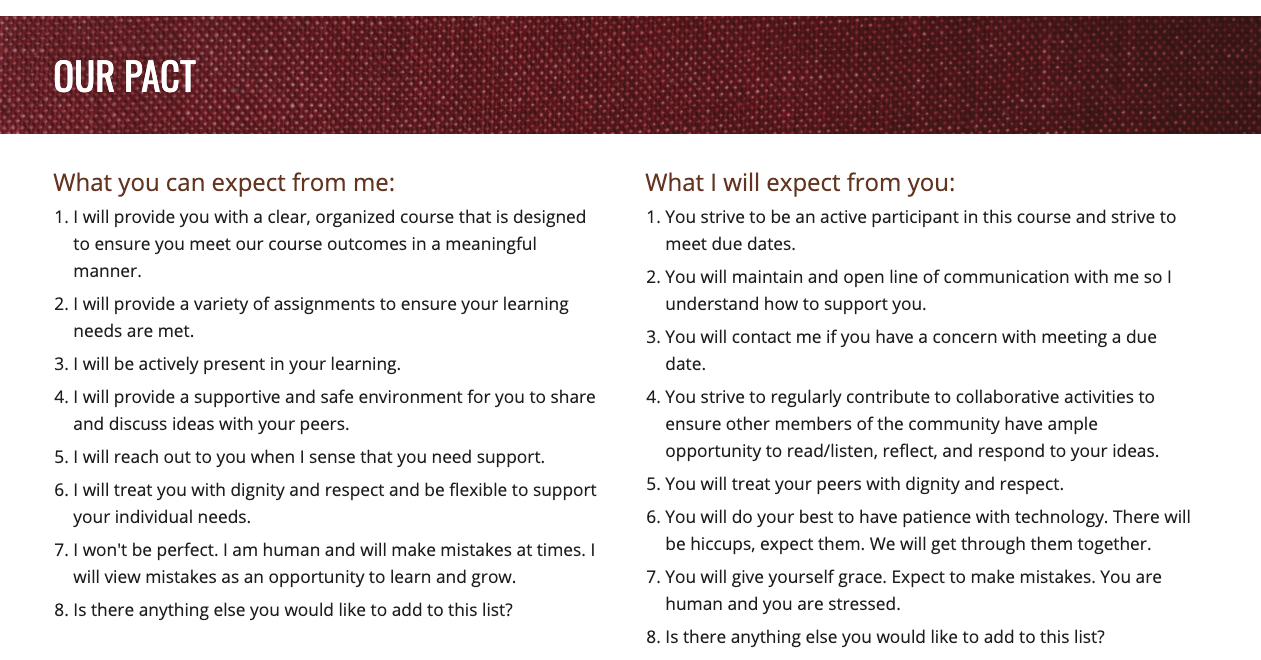
Teaching in Times of Trauma
While presenting ourselves as caring instructors is important in any types of class and times, it has become even more crucial during the Covid-19 pandemic, the social and political protests, and the upcoming election. What follows are some ideas on how to create a space for acknowledging and addressing trauma in our classrooms, as well as some ways to create connections and foster community building.
Class Activities
- Katie Linder calls for activities that help our students (and ourselves) cultivate resilience.
- Ask students to reflect on their takeaways from the pandemic and the fully-online situation: What will they take with them from this experience? What are they learning about themselves, their abilities, their strengths? Invite students to share their fears and to reflect on their values and how their values have helped them in times of adversity.
- Here’s a survey on personal strengths that can help students see what is particularly strong in their individual character and personality.
- Cathy Davidson encourages us to create activities for empowerment and agency, for example by letting students make decisions about the curriculum or the assignments. Also, consider creating activities that allow for creativity and the expression of joy.
- Students are more active in online courses because there is more individual work and fewer opportunities to let others do all the work during class activities. Knowing that, consider reducing the workload in your course. Make some of the activities optional or additional resources. Also, allow for some choices on which activities to complete and the tools to use to complete the work.
- A predictable routine in the course can have a calming effect when the rest of the world feels upside down.
Teacher Presence
In online classes, our role as instructors shifts to coaching and mentoring, so reshaping our teacher presence to embrace those roles can send a clearer message that we care about our students.
- Create a personable teacher presence through a welcoming homepage that uses colors and images on Canvas. Have an instructor card with your contact information and an instructor bio where you share your schooling, experiences, hobbies, research interests, etc.
- Share your own struggles as a writer with your students.
- Transform your syllabus into a liquid syllabus (it means that you are using a web tool to create a highly shareable and phone-friendly syllabus). Check the “Improving Course Navigation and Clarity” blog post on this website to find more ideas on how to improve the navigation of your course.
- In online settings, we miss the informal chit-chat of the face-to-face courses. Fabiola Torres creates non-instructional videos to show students some aspects of her life, such as her pets and garden (Clips on iPhones is perfect for these informal videos).
Making Connections with Our Students
Michelle Pacansky-Brock calls for humanizing our online teaching, and her website is rich in ideas on how to do it. Here are some of them:
- Send a welcome email to your students a week ahead the start of the course. This helps reduce student uncertainty and confusion. It also helps to check People on Canvas to see which students are not accessing Canvas and send them a quick note.
- Send out a survey at the beginning of the course asking students for their preferred pronouns and names, as well as an invitation to share their worries and goals with you.
- Be a “warm demander” and contact students when you see missing work.
- Canvas has a feature in Grades called Notes, which is not visible to students but allows you to keep quick notes near the students' names in the grade book. Use it to keep track of pronouns, nicknames, and difficult personal situations that the students have shared with you.
- Mid-quarter surveys are always useful to take the emotional temperature of our mostly invisible classroom. Google Forms can be very helpful to sharing the results with your students. Here's an example.
- Create a learning pact to tell students what they can expect from you and what you’ll expect from them.

Connections Between Students
- Discussion boards can be helpful for students to connect and create communities of care. Check the “Making the Most of Discussion Boards” blog post on this website for more ideas.
- Flipgrid can also be a useful tool for students to respond to each other through informal videos.
- Ask students to share with each other what they have learned in your class and to make connections on how it applies to their lives.
- Towards the last few weeks of classes, ask students to reflect on the successful strategies they’ve used in your course; share those with your new students at the beginning of the quarter.
UCD Resources
- This Frequently Asked Questions is an excellent resource to share with students (I recommend adding it to your Canvas site). It answers all sorts of questions students might have, from academic concerns to health and community needs.
- Student Affairs has put together a frequently asked questions that focus on how Covid-19 might impact students.
- Student Expression is a resource that deals with political and social protests and students needing to be heard.
- UCD mental health resources give you tips and strategies to deal with coping with these unsettling times.
- Another source from Student Affairs that helps students with practical questions.
- List of readings for instructors to help them create inclusive classrooms.
